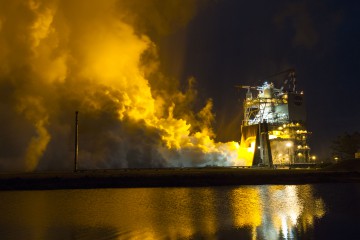
NASA is taking further steps bringing the agency closer to taking astronauts into deep space. Just weeks after a development engine test fire, and a month prior to a full-scale booster qualification motor test fire, NASA’s Space Launch System (SLS) launch vehicle continues its development as short-duration base heating tests continue on small-scale models.
Engineers from NASA’s Marshall Space Flight Center in Huntsville, Ala., are currently working with CUBRC, Inc., in Buffalo, N.Y., in testing two-percent scale models of the SLS propulsion system, which includes two five-segment solid rocket boosters, a core stage with four RS-25 engines (previously used during the space shuttle program), and a model of the entire rocket. These tests will provide NASA with more accurate data to aid in designing flight hardware and the system’s base thermal protection system, which must protect the crew and vital systems from heating effects.

NASA is aiming to perform an integrated systems test of SLS in late 2018 with Exploration Mission-1 (EM-1), which will take an uncrewed Orion Multi-Purpose Crew Vehicle (MPCV) and European Space Agency (ESA) service module on a circumlunar flight. The agency announced that for this flight, “ … [T]he SLS will feature a configuration for a 70-metric-ton (77-ton) lift capacity.” On future flights, the launch system is planned to have a lift capacity of 130 metric tons (143 tons). This capability, described as “unprecedented” by NASA, will be needed to loft the Orion spacecraft and associated hardware to deep space destinations such as Mars, or distant asteroids.
But before EM-1 launches in about 3.5 years (crewed missions are projected to start in 2020–2021), engineers must conduct extensive tests to gauge how this new system will perform. Enter the two-percent scale models, which are heated for very short periods of approximately 50-150 milliseconds at a time. Tests such as these are critical, as this new launch vehicle has never been flown in spaceflight history. Manish Mehta, lead engineer for the SLS Base Heating Test Program at Marshall, touched upon this fact.
“There’s a lot of complex work that goes in to such a short-duration test. The timing of the propulsion systems and shock tunnel have to be precise. Although this test program has been technically challenging, there’s no heritage data that we can fall back on to predict SLS base environments because this vehicle has never been flown before. There are four engines and two booster rocket plumes that are firing into the base. This results in highly complex flow physics, which is not something you can develop analytically and predict very accurately,” he stated.
According to NASA: “For the test series, which began in August 2014, the replicas are loaded with propellant, pressurized with hydrogen and oxygen lines and ignited in one of CUBRC’s shock tunnels. The shock tunnel replicates both supersonic and hypersonic flight conditions, matching what the rocket’s environment will be like during ascent, including temperature, pressure and velocity.” These tests allow engineers to duplicate flight conditions (albeit on a much smaller scale) on the ground. The models, designed over a 1.5-year period, may also be reused.

This series of 85 tests is planned to run through this summer. Just weeks ago, SLS passed another milestone as a development engine test fire took place at NASA’s Stennis Space Center near Bay St. Louis, Miss.
In a previous AmericaSpace article, Mike Killian wrote: “Locked down on the A1 test stand, Engine #0525 roared to life for 500 seconds, providing NASA engineers with critical data on the engine’s new state-of-the-art controller unit—the ‘brain’ of the engine, which allows communication between the vehicle and the engine itself, relaying commands to the engine and transmitting data back to the vehicle. Higher inlet pressure conditions, thanks to the engines upgrades, will also be evaluated. The new controller also provides closed-loop management of the engine by regulating the thrust and fuel mixture ratio while monitoring the engine’s health and status, thanks to updated hardware and software configured to operate with the new SLS avionics architecture. Engine 0525 is just a development engine, but the information it provides in testing will help perfect the engines that will fly on the SLS, starting with [EM-1] in late 2018.”
On the morning of March 11, Qualification Motor-1 (QM-1), a full-scale test model of SLS’s booster, will fire for two minutes during another critical test. Killian recently wrote: “The colossal 321-foot-tall SLS will thunder toward space on the power of four former (upgraded) liquid-fueled space shuttle RS-25 engines, but even with a combined thrust of nearly 2.5 million pounds those four engines alone won’t be enough to provide the 70-metric-ton (77-ton) lift capacity the initial SLS configuration promises. The rocket needs more power at launch to make NASA’s ambitious deep-space human exploration plans a reality, and this spring ATK is expected to test fire the largest and most powerful solid rocket booster ever built to help get the job done.”
In Orion news, the test capsule used during last December’s Exploration Flight Test-1 (EFT-1) will be put to work again during a mandatory ascent abort test, scheduled to take place in 2018. Called Ascent Abort-2 (AA-2), this mission “ … must be flown before any America astronauts will be allowed on Orion’s first crewed flight, currently targeted for about the 2020 to 2021 time frame,” wrote AmericaSpace’s Ken Kremer in December. This test will ensure the Launch Abort System (LAS) will be able to pull the capsule away from the launch vehicle and return astronauts safely back to Earth in the event a contingency occurs during ascent.
While NASA is still years out in its timeline from making its first SLS launch, this rigorous schedule of testing shows that soon enough, the science fiction-esque scenes in SLS animations will become science reality.
Want to keep up-to-date with all things space? Be sure to “Like” AmericaSpace on Facebook and follow us on Twitter: @AmericaSpace



